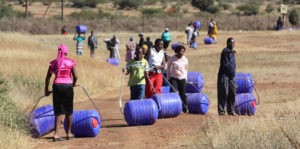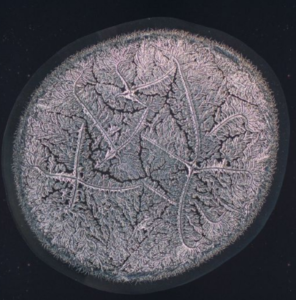Like many Portlanders, I enjoy visiting OMSI whenever I get the chance – whether to see my favorites among the permanent exhibits or to be surprised by new attractions. Some years ago, I viewed a temporary installation that showcased a number of low cost, innovative technologies whose aim is to alleviate the burdens of water hauling and purification that often plague remote, disadvantaged communities. In this blog post I would like to highlight two innovations whose simple design belie their powerful impact on providing clean drinking water.
 Women and children are often tasked with fetching water in poor rural areas while the men are engaged in gainful employment away from home. It is not unusual for women to balance loads on their heads where the absence of pack animals, back packs or push carts necessitates it. Naturally, this severely limits how much they can carry in a single trip. When children are responsible for fetching water, this can result in their having to miss school, since the journey to and from a water source can sometimes consume the better part of a day.
Women and children are often tasked with fetching water in poor rural areas while the men are engaged in gainful employment away from home. It is not unusual for women to balance loads on their heads where the absence of pack animals, back packs or push carts necessitates it. Naturally, this severely limits how much they can carry in a single trip. When children are responsible for fetching water, this can result in their having to miss school, since the journey to and from a water source can sometimes consume the better part of a day.
 The Hippo Roller was developed by a South African design team. It’s simple, durable design has won a number of international awards since its creation in 1991. The carrier consists of a 24 gallon polyethylene barrel which can be either pushed or dragged by its metal handle across rough terrain.Since effort is applied to spinning the barrel around its metal axis instead of carrying it, the Hippo’s effective weight is reduced to just 10lbs, even when filled to capacity. A single person, even a child, can therefore carry more water in a single trip, while simultaneously reducing the frequency with which water needs to be fetched. Currently, 49,000 Hippo Rollers are in use around the world.
The Hippo Roller was developed by a South African design team. It’s simple, durable design has won a number of international awards since its creation in 1991. The carrier consists of a 24 gallon polyethylene barrel which can be either pushed or dragged by its metal handle across rough terrain.Since effort is applied to spinning the barrel around its metal axis instead of carrying it, the Hippo’s effective weight is reduced to just 10lbs, even when filled to capacity. A single person, even a child, can therefore carry more water in a single trip, while simultaneously reducing the frequency with which water needs to be fetched. Currently, 49,000 Hippo Rollers are in use around the world.
 The Watercone desalination still is another low cost innovation that has garnered plaudits for its remarkable economy of design which essentially relies on sunlight and clear plastic to harvest fresh water. More surprisingly yet perhaps, its striking look has also attracted the attention of the art world : the Watercone has been exhibited at both MoMA NY and the Centre Pompidou in Paris. The still works by pouring salt or brackish water into the round, black dish that forms the bottom of the assembly. A transparent plastic cone is then set inside the rim of the dish and left in the sun for as long as possible. Evaporation distills the water, which condenses on the sides of the cone. When the cone is inverted, the now drinkable water can be drained into a container for use. Depending of the number of hours of sunlight available, the WaterCone can produce anywhere from 0.26-0.45 gallons of fresh water a day.
The Watercone desalination still is another low cost innovation that has garnered plaudits for its remarkable economy of design which essentially relies on sunlight and clear plastic to harvest fresh water. More surprisingly yet perhaps, its striking look has also attracted the attention of the art world : the Watercone has been exhibited at both MoMA NY and the Centre Pompidou in Paris. The still works by pouring salt or brackish water into the round, black dish that forms the bottom of the assembly. A transparent plastic cone is then set inside the rim of the dish and left in the sun for as long as possible. Evaporation distills the water, which condenses on the sides of the cone. When the cone is inverted, the now drinkable water can be drained into a container for use. Depending of the number of hours of sunlight available, the WaterCone can produce anywhere from 0.26-0.45 gallons of fresh water a day.
While one might be tempted to think of design as an optional luxury that adds beauty to one’s surroundings, the Hippo Roller and Watercone demonstrate how engineering acumen and design together can effect powerful change in communities that need it most.






